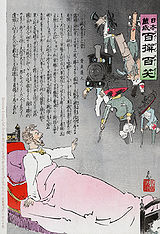
Kobayashi Kiyochika
Encyclopedia


Ukiyo-e
' is a genre of Japanese woodblock prints and paintings produced between the 17th and the 20th centuries, featuring motifs of landscapes, tales from history, the theatre, and pleasure quarters...
painter and printmaker of the Meiji period
Meiji period
The , also known as the Meiji era, is a Japanese era which extended from September 1868 through July 1912. This period represents the first half of the Empire of Japan.- Meiji Restoration and the emperor :...
.
Kiyochika is best known for his prints of scenes around Tokyo
Tokyo
, ; officially , is one of the 47 prefectures of Japan. Tokyo is the capital of Japan, the center of the Greater Tokyo Area, and the largest metropolitan area of Japan. It is the seat of the Japanese government and the Imperial Palace, and the home of the Japanese Imperial Family...
which reflect the transformations of modernity. He has been described as "the last important ukiyo-e master and the first noteworthy print artist of modern Japan...
The son of a government official, Kiyochika was heavily influenced by Western art, which he studied under Charles Wirgman
Charles Wirgman
Charles Wirgman was an English artist and cartoonist, the creator of the Japan Punch and illustrator in China and Meiji period Japan for the Illustrated London News....
. He also based a lot of his work on Western etchings, lithographs
Lithography
Lithography is a method for printing using a stone or a metal plate with a completely smooth surface...
, and photographs which became widely available in Japan
Japan
Japan is an island nation in East Asia. Located in the Pacific Ocean, it lies to the east of the Sea of Japan, China, North Korea, South Korea and Russia, stretching from the Sea of Okhotsk in the north to the East China Sea and Taiwan in the south...
in the Meiji period. Kiyochika also studied Japanese art under the great artists Kawanabe Kyōsai
Kawanabe Kyosai
was a Japanese artist, in the words of a critic, "an individualist and an independent, perhaps the last virtuoso in traditional Japanese painting"....
and Shibata Zeshin
Shibata Zeshin
was a famous and revolutionary Japanese painter and lacquerer of the late Edo period and early Meiji era. In Japan, he is ironically known as both too modern, a panderer to the Westernization movement, and also an overly conservative traditionalist who did nothing to stand out from his contemporaries...
.
His woodblock prints
Woodblock printing in Japan
Woodblock printing in Japan is a technique best known for its use in the ukiyo-e artistic genre; however, it was also used very widely for printing books in the same period. Woodblock printing had been used in China for centuries to print books, long before the advent of movable type, but was only...
stand apart from those of the earlier Edo period
Edo period
The , or , is a division of Japanese history which was ruled by the shoguns of the Tokugawa family, running from 1603 to 1868. The political entity of this period was the Tokugawa shogunate....
, incorporating not only Western styles but also Western subjects, as he depicted the introduction of such things as horse-drawn carriages, clock tower
Clock tower
A clock tower is a tower specifically built with one or more clock faces. Clock towers can be either freestanding or part of a church or municipal building such as a town hall. Some clock towers are not true clock towers having had their clock faces added to an already existing building...
s, and railroads
Rail transport
Rail transport is a means of conveyance of passengers and goods by way of wheeled vehicles running on rail tracks. In contrast to road transport, where vehicles merely run on a prepared surface, rail vehicles are also directionally guided by the tracks they run on...
to Tokyo. These show considerable influence from the landscapes of Hokusai
Hokusai
was a Japanese artist, ukiyo-e painter and printmaker of the Edo period. He was influenced by such painters as Sesshu, and other styles of Chinese painting...
and the work of Utagawa Kuniyoshi, but the Western influence is also unquestionable; these are much darker images on the whole, and share many features with Western lithographs and etchings of the time.
These were produced primarily from 1876 to 1881; Kiyochika would continue to publish ukiyo-e prints for the rest of his life, but also worked extensively in illustrations and sketches for newspapers, magazines, and books. He also produced a number of prints depicting scenes from the Sino-Japanese War
First Sino-Japanese War
The First Sino-Japanese War was fought between Qing Dynasty China and Meiji Japan, primarily over control of Korea...
and Russo-Japanese War
Russo-Japanese War
The Russo-Japanese War was "the first great war of the 20th century." It grew out of rival imperial ambitions of the Russian Empire and Japanese Empire over Manchuria and Korea...
.

